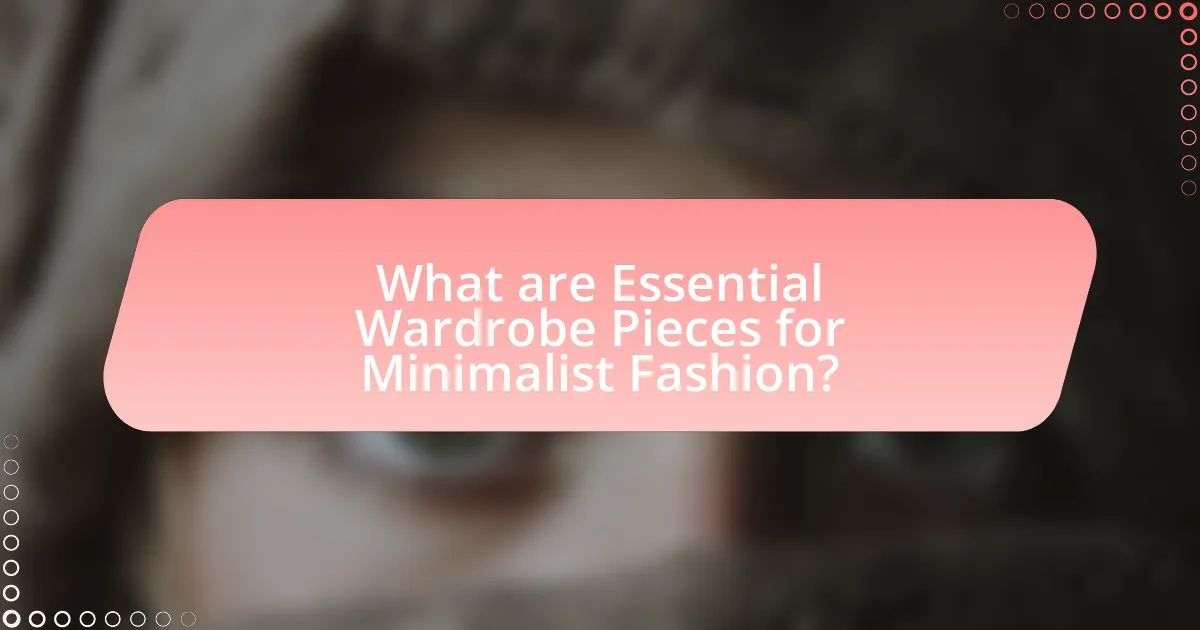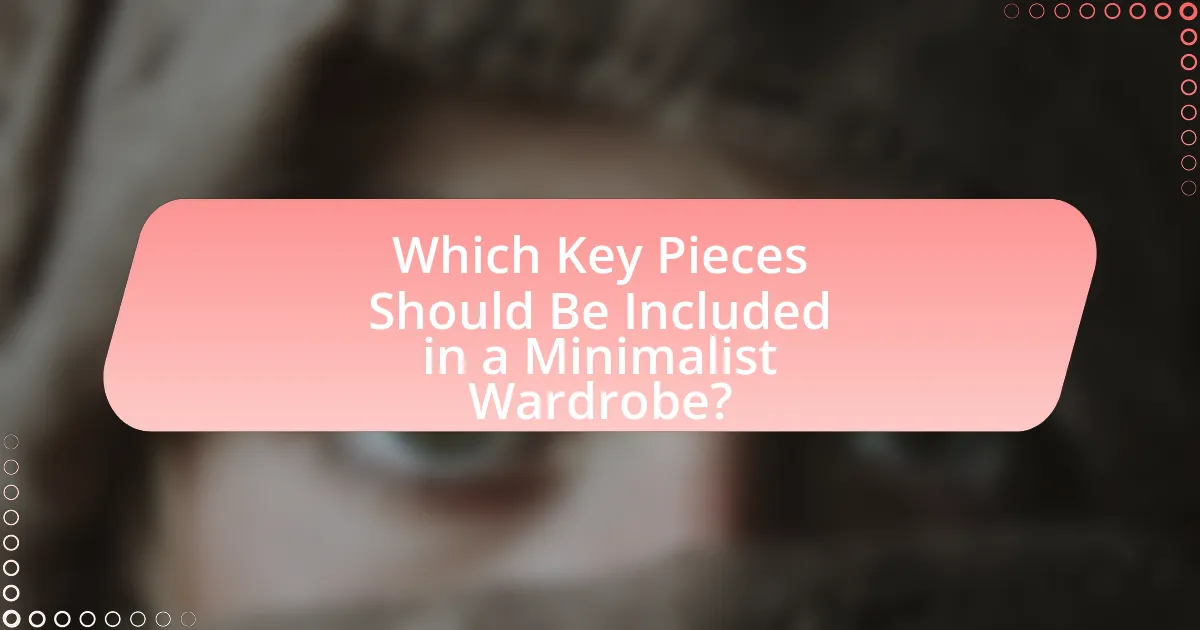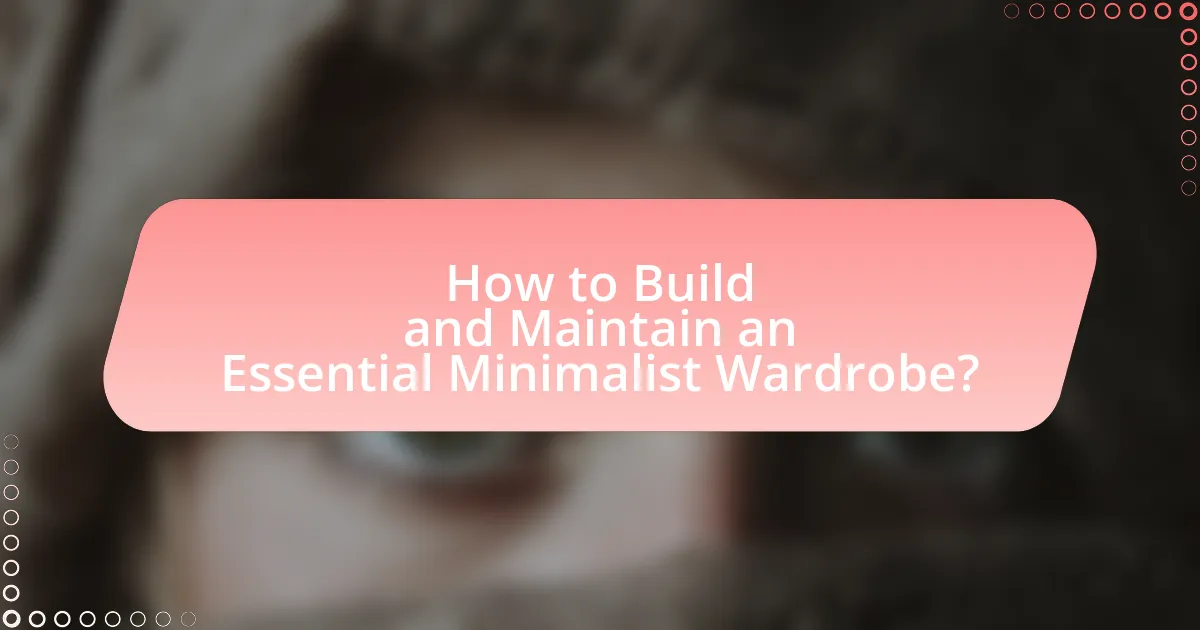Essential wardrobe pieces for minimalist fashion include a white button-up shirt, classic jeans, a tailored blazer, a little black dress, versatile shoes, and a quality coat. These foundational items are designed for versatility and can be mixed and matched to create various outfits suitable for different occasions, aligning with the principles of simplicity and functionality inherent in minimalist fashion. The article explores how these essential pieces contribute to a cohesive wardrobe, simplify daily outfit decisions, and promote sustainability by reducing consumption and waste. Additionally, it discusses strategies for building and maintaining a minimalist wardrobe, including the importance of a limited color palette and regular reassessment of clothing items.

What are Essential Wardrobe Pieces for Minimalist Fashion?
Essential wardrobe pieces for minimalist fashion include a white button-up shirt, a classic pair of jeans, a tailored blazer, a little black dress, versatile shoes, and a quality coat. These items are foundational because they can be mixed and matched to create various outfits suitable for different occasions. The white button-up shirt is timeless and can be dressed up or down, while classic jeans provide a casual yet polished look. A tailored blazer adds sophistication, and the little black dress serves as a go-to for formal events. Versatile shoes, such as loafers or ankle boots, complement multiple outfits, and a quality coat ensures warmth without sacrificing style. This selection is supported by the principles of minimalist fashion, which emphasize simplicity, functionality, and versatility in clothing choices.
How do essential wardrobe pieces contribute to a minimalist fashion style?
Essential wardrobe pieces are fundamental to a minimalist fashion style as they provide versatility and simplicity, allowing for a cohesive and functional wardrobe. By focusing on a limited selection of high-quality, timeless items, individuals can create numerous outfits without the clutter of excess clothing. This approach not only reduces decision fatigue but also promotes sustainability by encouraging mindful consumption. Studies indicate that minimalist wardrobes can lead to increased satisfaction and reduced stress, as individuals spend less time managing their clothing and more time enjoying their personal style.
What defines minimalist fashion in terms of clothing choices?
Minimalist fashion is defined by its emphasis on simplicity, functionality, and versatility in clothing choices. This style typically features a limited color palette, often consisting of neutral tones, and focuses on high-quality, timeless pieces that can be easily mixed and matched. Essential items include well-fitted basics such as plain t-shirts, tailored trousers, and classic outerwear, which are designed to create a cohesive and streamlined wardrobe. The minimalist approach prioritizes fewer, but more meaningful garments, reducing clutter and promoting a sustainable fashion ethos.
How can essential pieces simplify daily outfit decisions?
Essential pieces simplify daily outfit decisions by providing a versatile foundation that can be easily mixed and matched. These key items, such as a classic white shirt, tailored trousers, and a little black dress, allow individuals to create multiple outfits with minimal effort. Research indicates that a streamlined wardrobe reduces decision fatigue, enabling quicker choices and enhancing overall efficiency in daily routines. By focusing on quality over quantity, essential pieces foster a cohesive style, making it easier to dress appropriately for various occasions without extensive planning.
Why is it important to curate a minimalist wardrobe?
Curating a minimalist wardrobe is important because it promotes simplicity, efficiency, and sustainability in personal fashion choices. A minimalist wardrobe reduces decision fatigue by providing a streamlined selection of versatile pieces that can be easily mixed and matched, allowing individuals to save time and mental energy when getting dressed. Additionally, studies show that minimalism can lead to reduced consumption and waste, contributing to a more sustainable lifestyle. For instance, a report by the Ellen MacArthur Foundation highlights that the fashion industry is responsible for 10% of global carbon emissions, and adopting a minimalist approach can significantly lower one’s environmental impact by encouraging mindful purchasing and longer-lasting clothing choices.
What are the benefits of having fewer clothing items?
Having fewer clothing items simplifies decision-making and reduces stress related to outfit choices. This minimalism leads to a more organized wardrobe, making it easier to find and maintain clothing. Additionally, owning fewer items often results in financial savings, as consumers spend less on clothing and can invest in higher-quality pieces. Research indicates that a minimalist wardrobe can enhance personal style clarity, allowing individuals to express themselves more authentically. Furthermore, a streamlined wardrobe contributes to sustainability by reducing waste and the environmental impact associated with fast fashion.
How does a minimalist wardrobe promote sustainability?
A minimalist wardrobe promotes sustainability by reducing consumption and waste associated with fast fashion. By focusing on a limited number of versatile, high-quality pieces, individuals minimize the frequency of purchases, which in turn decreases the demand for mass-produced clothing that often contributes to environmental degradation. Research indicates that the fashion industry is responsible for approximately 10% of global carbon emissions, and a minimalist approach can significantly lower an individual’s carbon footprint by encouraging the use of durable items rather than disposable trends.

Which Key Pieces Should Be Included in a Minimalist Wardrobe?
A minimalist wardrobe should include key pieces such as a classic white shirt, a tailored blazer, a pair of well-fitting jeans, a little black dress, versatile shoes, and a quality coat. These items are essential because they offer versatility and can be mixed and matched for various occasions. For instance, a classic white shirt can be dressed up or down, while a tailored blazer adds sophistication to casual outfits. Research indicates that a streamlined wardrobe can reduce decision fatigue and enhance personal style, supporting the effectiveness of these foundational pieces in minimalist fashion.
What are the must-have clothing items for a minimalist wardrobe?
The must-have clothing items for a minimalist wardrobe include a white button-up shirt, a classic pair of jeans, a tailored blazer, a versatile dress, a neutral t-shirt, a pair of black trousers, and comfortable shoes. These items are essential because they can be mixed and matched to create various outfits suitable for different occasions. For instance, a white button-up shirt can be dressed up with a blazer for formal settings or paired with jeans for a casual look. Research indicates that a minimalist wardrobe can reduce decision fatigue and increase satisfaction with clothing choices, as seen in studies on consumer behavior and wardrobe management.
How do basic tops fit into a minimalist wardrobe?
Basic tops are fundamental components of a minimalist wardrobe, providing versatility and simplicity. They serve as foundational pieces that can be easily mixed and matched with various bottoms, allowing for multiple outfit combinations without excess clutter. The use of neutral colors and classic styles in basic tops enhances their adaptability, making them suitable for different occasions and settings. This aligns with minimalist fashion principles, which prioritize quality over quantity and encourage a streamlined approach to clothing choices.
Why are versatile bottoms essential for minimalist fashion?
Versatile bottoms are essential for minimalist fashion because they provide the foundation for a wide range of outfits while minimizing the need for excessive clothing. These bottoms, such as tailored trousers, skirts, or high-quality jeans, can be easily paired with various tops and accessories, allowing for multiple looks from a limited wardrobe. This adaptability aligns with the minimalist philosophy of simplicity and functionality, reducing clutter and promoting intentional choices in clothing. Studies show that a capsule wardrobe, which emphasizes versatile pieces, can lead to increased satisfaction and reduced decision fatigue in daily dressing.
How can accessories enhance a minimalist wardrobe?
Accessories can enhance a minimalist wardrobe by adding versatility and personal expression without overwhelming the simplicity of the outfit. For instance, a single statement necklace or a structured handbag can transform a basic outfit into a polished look, allowing for individual style while maintaining a clean aesthetic. Research indicates that accessories can significantly impact perceived style; a study published in the Journal of Fashion Marketing and Management found that accessories can elevate an outfit’s overall appeal by up to 50%. This demonstrates that carefully chosen accessories not only complement minimalist clothing but also enhance the wearer’s overall presence and style.
What types of accessories are considered essential?
Essential accessories for minimalist fashion include a quality watch, a versatile handbag, classic sunglasses, and simple jewelry. These items enhance outfits without overwhelming them, aligning with the minimalist aesthetic that emphasizes simplicity and functionality. A quality watch serves both practical and stylistic purposes, while a versatile handbag can transition between various occasions. Classic sunglasses provide protection and style, and simple jewelry adds a touch of elegance without being excessive. These accessories are foundational in creating a cohesive and stylish minimalist wardrobe.
How do accessories contribute to outfit versatility?
Accessories enhance outfit versatility by allowing individuals to transform a single base outfit into multiple looks. For example, a simple dress can be styled with different accessories such as belts, scarves, or jewelry to create distinct appearances suitable for various occasions. This adaptability is supported by fashion studies indicating that accessories can change the perception of an outfit, making it more formal or casual depending on the chosen items. Thus, the strategic use of accessories is essential for maximizing the functionality of a minimalist wardrobe.

How to Build and Maintain an Essential Minimalist Wardrobe?
To build and maintain an essential minimalist wardrobe, start by selecting versatile, high-quality pieces that can be mixed and matched. Focus on a limited color palette, typically neutral tones, to ensure compatibility among items. Essential pieces include a classic white shirt, tailored trousers, a little black dress, a well-fitted blazer, and comfortable footwear.
Regularly assess your wardrobe by removing items that you haven’t worn in the past year, ensuring that each piece serves a purpose or brings joy. This practice aligns with the minimalist philosophy of quality over quantity, promoting a streamlined and functional wardrobe. Studies show that a minimalist approach can reduce decision fatigue and enhance personal style, making it easier to dress efficiently.
What strategies can be used to select the right pieces?
To select the right pieces for a minimalist wardrobe, prioritize versatility, quality, and timelessness. Versatile pieces can be styled in multiple ways, such as a classic white shirt that pairs well with various bottoms. Quality ensures longevity; for instance, investing in well-made shoes can reduce the need for frequent replacements. Timeless styles, like a little black dress or tailored trousers, remain fashionable across seasons, minimizing the need for constant updates. Research indicates that a curated wardrobe of around 30 essential pieces can lead to more efficient dressing and reduced decision fatigue, supporting the minimalist approach.
How can one assess personal style needs for a minimalist wardrobe?
To assess personal style needs for a minimalist wardrobe, one should evaluate their lifestyle, preferences, and existing clothing items. This involves identifying key activities and occasions that require specific attire, determining color palettes that complement personal aesthetics, and analyzing current wardrobe pieces for versatility and functionality. Research indicates that a well-curated minimalist wardrobe typically consists of around 30 to 40 essential items, allowing for a cohesive and adaptable style. By focusing on quality over quantity, individuals can ensure that each piece aligns with their personal style and serves multiple purposes, thereby enhancing the overall effectiveness of a minimalist approach.
What role does color palette play in a minimalist wardrobe?
A color palette plays a crucial role in a minimalist wardrobe by ensuring versatility and cohesion among clothing items. A well-defined color palette allows individuals to mix and match pieces effortlessly, maximizing outfit combinations while minimizing decision fatigue. Research indicates that a limited color palette can enhance the perceived value of clothing, as seen in studies on consumer behavior, which show that cohesive color schemes lead to higher satisfaction and reduced clutter in personal style. Thus, a strategic color palette not only simplifies the dressing process but also elevates the overall aesthetic of a minimalist wardrobe.
How can one effectively maintain a minimalist wardrobe over time?
To effectively maintain a minimalist wardrobe over time, one should regularly assess and curate their clothing collection, ensuring that each item aligns with personal style and functionality. This involves conducting seasonal reviews to remove items that are no longer worn or do not fit, which helps to keep the wardrobe streamlined and relevant. Research indicates that individuals who engage in regular decluttering are more likely to maintain a functional wardrobe, as it prevents accumulation of unnecessary items and promotes mindful purchasing habits.
What are the best practices for decluttering clothing items?
The best practices for decluttering clothing items include assessing each item for its utility, emotional value, and frequency of wear. Start by categorizing clothing into keep, donate, and discard piles, ensuring that items kept are worn regularly and serve a purpose. Research indicates that individuals who regularly declutter report increased satisfaction and reduced stress, highlighting the psychological benefits of maintaining a streamlined wardrobe. Additionally, the “one in, one out” rule can help prevent future clutter by ensuring that for every new item acquired, an old item is removed.
How often should one reassess their minimalist wardrobe?
One should reassess their minimalist wardrobe at least twice a year. This frequency allows individuals to evaluate their clothing needs based on seasonal changes, lifestyle shifts, and personal preferences. Research indicates that regular reassessment can lead to a more functional and satisfying wardrobe, as it encourages the removal of items that are no longer worn or needed, thus maintaining the core principle of minimalism.
What are practical tips for adopting minimalist fashion?
To adopt minimalist fashion, focus on curating a capsule wardrobe consisting of versatile, high-quality pieces. Start by selecting a limited number of essential items that can be mixed and matched, such as neutral-colored tops, tailored pants, and classic outerwear. Research indicates that a capsule wardrobe can reduce decision fatigue and streamline daily outfit choices, enhancing efficiency in dressing. Additionally, prioritize quality over quantity by investing in durable fabrics that withstand wear, as this approach not only promotes sustainability but also ensures longevity in your wardrobe.


